
It's not an offer you get everyday really. After extending my stay on the bear project for the third time, I'm finally on the verge of turning in my gumboots and taking to the road again. There's a whole continent of adventure still waiting for me and as much as I'm enjoying tracking bears it's time to move on. So is my thinking on the morning when, sitting in a clearing and watching a lazy, white cloud drift through the valley below me, Armando asks me if I want to rehabilitate an Andean Bear and then release it into the wild.
I consider my options. Sprawled out before me is a banquet of cultural and natural delights: the humid expanse of the Amazon jungle, Machu Pichu and the mysterious ruins of the Incas, the ski slopes of Chile, the fabled feasts of Argentina and the beaches, parties (and women!) of Brazil. While here, on the other hand, I have a chance to do something no other bum backpacker (and definitely no IT geek) has ever been able to do: a chance to work face to face with the shy, elusive creature that I've spent the last three months tracking without ever catching a glimpse of; a chance to do something really worthwhile, something that will significantly contribute to the conservation of the Andean Bear; a chance to do something pretty damn cool.
In the end there is only one choice, the sights of South America will be there when I'm ready for them but an offer to rehabilitate and release a bear is not coming along again anytime soon. I accept Armando's offer and then dedicate myself to the task of finding out exactly what "bear rehabilitation" actually means. I'm guessing it doesn't involve taking them to help groups and getting them to stand up and admit they have a problem but other than that it's all new territory for me.
The reason Armando needs me to do this work, as opposed to doing it himself, is that after months of working with government officials and the owners of Yanahurco in the Cotopaxi reserve (where the bear is to be released), the rehab of the bear now coincides with the time when Armando is off to Italy to speak at an International Bear Conference (it's amazing what weird and wacky things people do behind closed doors). Armando will be back for the actual release but for the bulk of the rehab he will be in a continent far away.
This is the seventh bear released by the project and Armando at least has some documents to help me out. They're all in Spanish but I surprise even myself when I discover this isn't a problem for me anymore. The basic concept is pretty simple really; the main focus of the rehabilitation is to change the bear's diet from the junk it is currently eating to what it will be eating in the wild. This is primarily so the bear can identify food sources in the wild and not starve to death but also to gradually prepare the bear's digestive system for the change (I'm familiar enough with the affects that a sudden change to a foreign diet can have to appreciate the need for this).

I head out to the
Santa Martha Animal Rehabilitation Centre where my bear is currently living. Santa Martha is owned by the Fundacion Espiritu del Bosque (i.e. the Spirit of the Forest Foundation), the same foundation that runs the bear project. It's a centre that focuses on the rehabilitation of native animals with the aim of releasing them back into the wild. In many ways it resembles a zoo, the main difference however is that where zoos aim to collect as many animals as possible and keep them for as long as possible, Santa Martha aims to get rid of as many animals as possible and, in a perfect world, would have all its cages empty.
I meet my bears. Only one, the female, is going for release this time round but she shares an enclosure with three younger males. This is the first time I've ever seen an Andean Bear, apart from in photos, and I am instantly in love with them. They are like massive puppies: big, clumsy-looking balls of fluff that pull and play with anything they find in front of them. They're not exactly tame but they don't have that "I want to rip your guts open, eat your heart and floss with your entrails" look that most wild animals, especially the big cats, have. These guys want to play with me, it's just that their version of "playing" would end with me picking up my limbs off the ground.
At first the bears all look pretty similar to me but part of my assignment is to observe them while they eat and interact. I spend hours sitting next to the enclosure, in the sun and in the rain, watching them go about their day-to-day activities. It's not long until I can tell each bear apart from just a glance. These bears are called spectacled bears because of the white rings around their eyes. Each of my bears has a different look to their rings and once you get to know them, these are as distinctive as the markings on a human face.
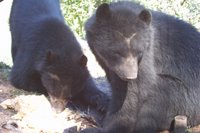
The two big boys are called Leonardo and Gabriel. These guys are twin brothers and although they are only around two years of age and eight months younger than the female, they are half again her size. The markings on Gabriel's face form a thin little 'Y' shape and hardly circle his eyes at all. Leonardo's markings on the other hand are thick, shaggy and look more like a splatter of paint. You can always find Leonardo in a crowd because of his wet, orange ears. For some unknown reason Gabriel likes to suck on Leo's ears (making some very disturbing sounds of pleasure while he does it) and never once did I see Leo with dry ears.

The youngest bear is Beto. This little guy is the smallest of the lot when I arrive but in the month that I'm working with them he almost doubles in size and out-grows my female. Beto has very straight, thick eye markings that form a nice bushy mono-brow across his forehead. He's probably about a year and a half old and, being in that experimental phase of his life, can often be seen (and heard) pleasuring himself.
Bears have incredible flexibility and Beto regularly curls himself up in a ball and gives himself a bit of a lick and tickle, earning himself the nickname of "Willy" from the other volunteers at Santa Martha. Beto was high up in a tree one morning, indulging in a bit of oral pleasure, when he got so carried away that he fell backwards out of the tree, plummeting three or four meters to the ground below. Luckily bears are pretty damn tough and he was unhurt, but he has learnt not to give himself blowjobs in trees anymore.

And then of course there's my girl: a sleek little creature, almost delicate looking alongside the shambling bulk of the males. She's adorned with petite, little eye-rings. The one over her left eye forms a near-perfect half-moon but the one over her right eye has a distinctive break in the middle of it. She's nearly three years old and is just about fully-grown for a female. The males, when fully grown, will be nearly double the size of most females.
My first, and unexpected, obstacle is working out just what the female's name actually is. With each of the different little groups of the foundation she has a different name. On the bear project she's referred to as Colleen, in honour of an American woman that helped set up the foundation and was very involved in its early days, especially with setting up the volunteer program. At Santa Martha I'm told she's called Rosita. When I mention this to Armando, he tells me that it's actually Osita, a nickname meaning "little bear" but Johnny, who runs Santa Martha, is adamant that it's Rosita. Just to make matters more interesting, Dave tells me that she was originally called Maria, though he seems to be the only one who knows this. I decide to go with Rosita, it has a nice ring to it, and it suits her: the little Rose.
All of these bears have come to Santa Martha via the police after raids on homes where the bears have been kept illegally as pets or have been on their way to the animal black market. All were cubs when they arrived and have been raised at Santa Martha by volunteers, often being bottle fed for the first few months after their arrival. The two brothers were around three months old when they were found in someone's backyard here in Ecuador where they were kept with chickens in a coop.
Once the bears were weaned off the bottle they moved onto a fruit and oat mix. Two buckets of watermelon, pineapple, rock melon, banana and papaya are fed to them each morning and night. Once or twice a week the bears are given a dead chicken to eat to keep up their protein levels. This wasn't enough to keep them healthy however and in the last six months or so, their diet has been supplemented with a couple of scoops of dog biscuits.
Unfortunately for Rosita, this delicious diet can't be maintained in the wild. There just aren't any naturally growing dog-biscuit trees in the Cloud Forests of Ecuador. Out there she's going to eat bamboo, bromeliads, the heart of palm trees, the occasional bush fowl and as many grubs, worms and insects as she can find. So this is my job: to convince Rosita that the diet of sweet fruit and filling dog biscuits she's been living on (the equivalent of bear ice-cream) is no where near as delicious as the tough, fibrous plants and squishy bugs she'll get in the wild (the bear equivalent of rice and brussel sprouts).

My job is to be made a little easier since the boys are being moved to a new cage, in preparation for the arrival of two other adult bears from another zoo down south in Ecuador. Rosita is to be left on her own in the old cage for a few weeks while the younger boys are moved into a re-furbished cage, previously home to a lion. I spend my first week working with the other volunteers at Santa Martha (mostly female, once again), strengthening the cage and making it bear proof. The work is supervised by a couple of Ecuadorian cow farmers and the usual Ecuadorian approach is used, i.e. no need for planning, just knock it up and see how it looks. We all have our doubts about the strength of the cage but we defer to the wisdom of the Ecuadorians who, in typical Ecuadorian fashion, claim expertise in every field they turn their hands to.
Leonardo, one of the foundation founders, the namesake for one of the bears, and the vet for both the bear project and Santa Martha, turns up on the designated day to drug and move the boys. I've spent a bit of time with Leonardo before this and he's one of those easygoing, likeable people that you never meet often enough. As with everything with this foundation, money (or rather, lack of it) dictates the proceedings and Leonardo has only a bit of PVC piping that he uses as a blow dart to drug the bears. He's also only got three darts so when he misses Gabriel with one of his shots, one of the volunteers has to run in and grab the dart while the rest of us distract the other bears. It's all very professional.
Eventually we manage to get all three of the boys drugged. Rosita is hiding in the far corner of the cage throughout the whole venture. She's familiar with Leonardo and his blow dart and the moment he nears the cage she's off - as quickly as any pet dog when it hears the word 'vet'. We enter the cage without having to worry about Rosita bothering us and drag out the boys. Again the tight budget is evident: there's no stretcher or anything like that to carry them on so we use the small, metal door to the cage. We have to hold the bears on by whatever we can get hold of, be it feet, ears or tufts of fur, to stop them from sliding off as we lug them down to the new cage.
Eventually we get all three of them into the new cage and shut the door. Gradually they come to and struggle onto their feet. They look like I do on a Sunday morning after a big night out on the town. They stagger around the cage looking well pissed off and understandably confused. They've lived in their old enclosure for over a year and this is the first time they've seen anything different.
They're hungry too. We've not been able to feed them for two days because of the drugs used to move them. We still have to wait a while longer before we can give them solids but we fill up their water bowl for them. They down this immediately and we have no way of telling them to take it slow. Within a few minutes they're all throwing up water all over their nice new cage. It's really not been a good morning for them.
We watch them for a while to make sure that they are OK and then leave them to recover in peace. The other volunteers head off to feed the monkeys, or clean the lion cages or whatever other unappealing job Leon has for them. I head off for bromeliads for Rosita but drop back in to see the other boys late in the afternoon. They are really not impressed with their new cage and they have stripped every bit of wood in it. They've also pulled and played with every loose bit of wire and every support beam in reach. When I come down Beto is hanging from the roof of the cage (some two or three meters off the ground) trying to pull it down. Still the cage seems to be holding up and I head up to have dinner.
Just after dinner the message comes in that a farmer driving past has seen a bear wandering free in a field. The boys have escaped. It's dark but we head down anyway to see if we can do anything. There are about ten volunteers along with the two Ecuadorians that were responsible for the cage building. Chiquita, my small puppy in training to be a bear tracker, tags along as well, despite my attempts to stop her. We hurry down to the bear cage with our torches and a few buckets of bear food.
Luckily the boys’ hunger has dictated their movements. We find them loitering around the cage looking for food. This is where they've been fed everyday for the last year or so and to them this is where dinner should be. Even though we've found the bears we still have the difficult task of luring them into the cage. We open the door and Leo wanders straight in and heads for the food bowl. Beto is close but won't enter the cage. Despite being a young guy he's pretty smart and isn't falling for such a simple ruse. One of the Ecuadorian guys grabs him from behind by the scruff of his neck. This isn't exactly the smartest thing to do but Beto is small enough that he gets away with it.
There's no way we can drag Gabriel in using this same method though, he's huge and he's still a little pissed about the whole bit where we drugged him and dragged him by ears into a new and scary place. A couple of the team head down behind him and try to scare him into the cage by yelling loudly and whacking the ground with sticks (of my precious bamboo!). This has the affect of scaring the shit out of Gabriel but instead of heading into the cage as expected he bolts. One of the Ecuadorian guys is in his way and he turns and runs, heading straight for myself and a group of volunteers.
It's dark enough that all we see at first is the Ecuadorian legging it up the hill towards us. He literally pushes over some of the girls as he bolts along the small path, yelling something unintelligible in Spanish. A few seconds later we see the bear: a huge bulk of muscle and fur thundering its way towards us. In reality the bear is just trying to escape and has no interest in attacking us but at the time there's little time to think this through and even so I don't think it would have made much of difference to any of us.
The group scatters in all directions. I'm at the front of the crowd and there's nowhere for me to run so I dive over the nearest bush. Only Chiquita stays behind either too brave or too stupid to run. Showing her true bear tracking spirit, she stands her ground barking her little puppy bark as the bear charges towards her. Despite the difference in size the bear is actually put off enough by the defiant, barking Chiquita that he slows before reaching us. This brief lull is all that myself and a few of the other volunteers need. We charge back towards the bear whooping and yelling. He turns back down the hill and, now surrounded by crazy, yelling humans, bolts for the safety of the cage. We slam the door shut and bolt it behind him.
With the bears all safely back in their original enclosure we head down to the cage that they escaped from. We quickly spot the point of their escape. The boys, in their frustration at being somewhere new with no food, have bent back some of the thick steal mesh in the corner of the cage. It's a decent effort; I doubt I could have done the same with the aid of a crow bar and a hammer. More amazing is that this cage was home to several large cats for years before the bears moved in. The cats never came close to escaping but these agile and strong bears were out in less than a day.
No harm has been done however. The bears are all safely back in their original enclosure and, after a decent feed, have settled down for a nice snooze. The decision is made not to move them again. Although we could fix the point of escape, there's no way to know whether the bears will be able to escape again. On top of this it's not real safe to drug the bears too often and we are reluctant to dose them again so soon. This is all fine except I'm once again left with the task of providing natural food for four hungry, growing bears instead of one.
I start with bamboo as this is the most important part, and in the wild usually makes up about 70% of a bear's diet. Having lived out on the bear project for the last three months I'm confidently expecting that huge swathes of bamboo forest will surround me on all sides. I'm a long way wrong. Santa Martha is south of Quito and is in an area famous for its lucrative dairy farms. The area is highly cultivated and, despite walking for days in every direction, and asking every farmer I can find (and earning myself some very strange looks), the best bamboo I can find is barely a centimetre in diameter. The bears think this stuff makes great toys and love wrestling with each other over it but there's no chance they're mistaking this for food.
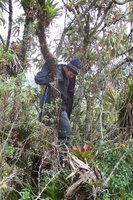
I put bamboo on hold for a few days and focus on Bromeliads. These are the large flower-like plants that grow in the branches of trees. Here I have more luck, all along the river the trees are covered with bromeliads of all shapes and sizes. The trees are thick branched and, apart from the spiders and the thorny bushes, make great climbing. Each morning I head off with my sacks and my machete and spend hours clambering up trees and ripping down these plants. The shape of them form a natural bowl that catches rain water and when I pull them down, this stagnant, foul-smelling brew pours out all over me.
When I first start collecting bromeliads, I'm a little casual about where I get them from. I'm used to the friendly farmers of Intag who see you walking onto their land as a chance to make a new friend, show off whatever weird crop they grow, and convince you to marry their daughter. I expect these farmers near Santa Martha to have no problem with me climbing some trees on the edge of their properties to pull down a few useless bromeliads. Following the river one day I find out just how wrong this assumption is.
The river is the border of Johnny's land and I spend a good hour collecting bromeliads from his side of it. I spy a few tasty looking subjects on the other side of the river however and scramble across. I'm standing there on the neighbour's land, probably only about three meters from the river bank, looking up at my prey and trying to work out the best way to climb up to get them. Behind me I hear someone approaching and I look up the path to see a farmer descending towards me. I wave to him and offer a friendly "buenos dias". There's no response and it's when he's about ten meters away I notice he's holding a rifle in one hand and a machete in the other. He doesn't look too happy either.
He stops in front of me, cocks his rifle and then raises it about a meter in front of my face, giving me the best view I've ever had of the inside of the barrel of a loaded rifle and also a reason to buy new underwear. He still hasn't said a word and there's a healthy anger in his eyes, this man wants blood. I realise I'm still holding my machete and I drop it quickly. I pour out Spanish, explaining what I'm doing, who I'm working with and that I didn't realise it was his property (the last was a blatant lie but, given the circumstance, my conscience is clean).
He keeps the gun aimed at my head for a good five minutes while I talk, occasionally he asks me questions such as Johnny's last name and the name of the reserve: questions to test my true identity. It seems a little extreme, I've already shown him my bag full of worthless bromeliads, I'm clearly a gringo foreigner, I'm wearing a white shirt and tan pants, my machete has a fluorescent orange handle and I'm wandering around in clear site in the middle of the day. If I truly am the cow-rustling bandit this man thinks I am, I'm in the running for the top prize on World's Dumbest Criminals.
Finally I convince him I'm not there to steal his cows and he lowers his gun (with a somewhat disappointed look on his face). Having decided not to shoot me, he now decides we can be mates. He engages me in a friendly conversation about Australia, about the bears, about Santa Martha and about Ecuadorian women. I answer all his questions as politely and in as friendly a way as I can (the gun is still loaded after all), all the while trying to work out whether I've shat myself or not. After a half hour chat he finally shakes my hand, calls me his "Amigo" and heads back to his farmhouse. I grab my sack of bromeliads and all but run back across the river and up to the bear cage. That's all the bromeliads the bears are getting this day and in subsequent expeditions I keep well within the bounds of Johnny's property.
Armando comes out to check on me before heading off to Italy. After showing him the pathetic bamboo I've managed to find he takes me down to a local reserve called Pasochoa. It's only a half hour drive from Santa Martha and has around 500 hectares of undisturbed forest, swarming with thick, green bamboo. The rangers here know Armando from years back and they kindly allow me to come down twice a week and cut bamboo for my bear. It's a beautiful little site and I'm not at all unhappy about working there. The place actually charges tourists ten dollars to visit for the day but I'm allowed in for free (all I have to do is show my trusty machete).
Johnny is suppose to drive me down to the site and pick me up after cutting for a day but the man runs an animal centre with everything from ocelots, to ex-circus lions, to a Houdini-like tapir that refuses to live in its cage and spends its days wandering with the cows. On top of this, Johnny has a hundred head of cattle that need milking and constant care. Despite his best intentions he has no time to help me on this venture. I end up walking down to Pasochoa each time, a two and a half hour walk. I then cut bamboo until the light begins to disappear. Sometimes Johnny picks me up, but usually I walk back up the hill and get him to come down the next day. By the end of it all I'm sick enough of waiting that I end up organising a local taxi (i.e. truck) to come pick up both my bamboo and me.
My arrival at Santa Martha inconveniently coincides with the start of the rainy season. Although the mornings are usually warm and sunny, everyday at around lunchtime the sky turns an angry black and the gods bellow thunder at me and hurl down lightning and rain. Most of my bamboo chopping is done with cold water dripping over my hood and heavy mud sucking at my boots. Most of my trips I do alone and the work is hard and slow going. Cutting enough bamboo to feed four growing bears is no easy task. The bamboo stalks are usually more than four meters long and they're heavy. Dragging thirty or forty stalks down the small paths in the pouring rain takes the full day. After setting off at six in the morning and getting home at around eight in the evening I usually have just enough bamboo to last my bears for half a week or so.
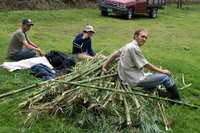
Towards the end of my stay there I finally manage to organise things with Leon (the volunteer coordinator at Santa Martha) and Johnny so that I get three or four volunteers to accompany me on the trip down to cut bamboo. We descend on Pasochoa with our machetes and set about hacking through the pristine reserve. The rangers look a little worried when they see us but they let us do our job so long as we stop chopping when other tourists come through. Every time they bring through a group of Ecuadorian school kids or a load of elderly tourists we sit down and try to look as inconspicuous as a group of machete wielding gringos can look while sitting next to a pile of chopped bamboo in an Ecuadorian reserve.
With this many people the job of cutting bamboo becomes a lot easier and we usually finish before the rains kick in at midday. This allows me to focus on my other assignments: worms and crickets, the bears need to learn that both of these are a food source. Crickets prove to be easy. The long grass fields around Santa Martha, which are used to fatten the dairy cows, are crawling with colonies of them.

I wander through the fields swiping at hapless bugs and loading them into my little plastic container. The bears love them. They line up along the edge of the cage like kids in a lollie shop, pushing and shoving at each other to get to the bugs. Their eyesight is pretty poor however and my attempts at throwing crickets into the enclosure in the hope that they will catch them fail miserably. I have to hand feed them through the cage and I'm amazed how delicately they lick the tiny bugs from out of my fingers without ever once biting me.
Worms prove a little more difficult. Despite spending my days digging through the soggy swamps that now surround Santa Martha due to the heavy rains, I find only a handful of worms. Eventually I am forced to resort to the undignified job of digging through the piles of steaming cow and horseshit that litter the fields. I have a little more success with this, but still, after hours, wrist-deep in shit, I have barely enough worms to feed one bear, let alone four.
There's only one option left: the massive pile of rotting compost. This wretched, foul-smelling mound is the result of years of volunteers dumping their organic waste. The rate of food scraps added to it far exceeds the rate of decomposition and the pile is over a meter high. I grab a small trowel and dive in and I am quickly rewarded with a seething colony of worms. I grab huge handfuls of them (mixed with rotting fruit, eggshells and other less pleasant and less identifiable scraps) and bundle them into my container.
I head down to the bears with my bounty of worms and the bears, recognizing my container as the one that provides the cricket goodness, come bounding up to me. I hand feed the worms to them through the cage wire but the bears are not at all impressed. The boys, especially Beto, gobble down a handful each before losing interest and wandering off to climb a tree or to have a snooze (or in Beto's case, a wank). Rosita is even less appreciative of my efforts. She takes one worm off me, chews it a little and then spits it out in disgust. She turns her back on me in disdain and wanders off. Such is the reward I get for my hours of picking through shit.
As well as the intensive, time-consuming work of the rehabilitating Rosita, I also volunteer myself to rebuild
the website for the bear project. The biggest problem with this project is one of publicity. Since few people know they exist, few volunteers find their way here and few people who would otherwise donate to the cause have no way of doing so. I set myself the challenge of changing this and many a night I am up to the early hours of the morning trying to jam more information into the site. I even add an
online donation section so that all those people reading my blog and feeling like they want to help out could do so from the comfort of their living rooms (and yes that was a blatant and shameless attempt to get you to donate. Don't make me beg).

I end up working at Santa Martha for a little over a month. My life begins to mimic that of a bear. I spend my waking hours climbing trees in search of the freshest and juiciest bromeliads. I get excited when I find a particularly large bromeliad as these are often crawling with small spiders, bugs and the occasional frog, all of which the bears love. I spend hours chopping stalks of bamboo and, since I need to test the stuff for softness and freshness, start to develop a taste for the fibrous stuff. I find myself chewing on stalks of the hard celery like stalks as I work. Most of my work (both the bear rehab and the website work) is done alone and, like the wild bears themselves, I have hours to myself, wandering through fields and forests and after a few weeks I grow more used to my own company and find myself almost uncomfortable around the other volunteers at meal times.
Eventually Rosita is ready. Apart from the bamboo and bromeliads I also manage to locate some palm trees on a small trip back to the main bear project. With a couple of volunteers from the bear project we chop down a few of these and I take the soft "hearts" of the palm trees back for my bears. Rosita loves them. It's the only food I've seen her fight over. Usually when the bigger boys approach she'll move off and leave what ever she's eating behind for them. With these palms however she runs up the nearest tree with her treasure and if the boys try to follow her she gives them a heavy slap, a snarl and sends them on their way.
As well as the palms I also get Johnny to take myself and a couple of other volunteers up to the nearby paramo (the mountain grass-lands that exists above the tree line throughout the Andes). The views from up here are spectacular, we can see for miles and the snow capped outline of the Cotapaxi reserve looms over the horizon. A few of the rare giant Condors circle slowly overhead as well and we are treated with a fantastic view of them.
It's not the views that we are for however. The bears use the paramo to move between patches of forest and they can sometimes spend days travelling along the border between the forest and the paramo. Up here there main food source is a special type of bromeliad called Puyas. We spend a few hours in these cold, windy highlands collecting these tough, spiky plants for the bears to eat. We load them into the back of Johnny's truck and take them back to the enclosure. The Puyas prove to be too tough for Rosita but the boys manage to crack a few open and munch them down. Rosita finishes off whatever they leave behind but never manages to open any herself. This is probably not a huge problem however, as the males are the ones that do the bulk of the travelling. Rosita should be able to survive without this food source if she still can't work out how to open them once she's in the wild.
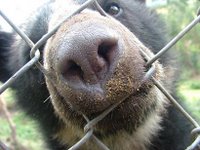
Eventually my job is almost done. Rosita knows how to eat most of the foods of the wild and once Armando has returned from Italy he agrees that she's ready to go. As the day approaches for her release, I'm both a little sad that she will be gone and a little glad that I no longer have the exhausting task of feeding her. Only one last job is left: to release her into the wild.
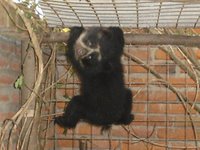
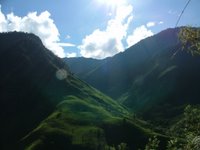

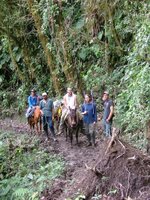
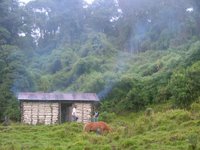
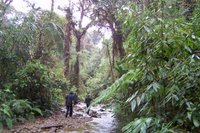

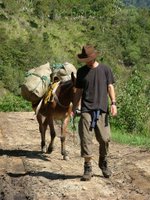
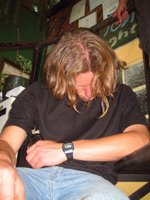

 Click here to
Click here to 
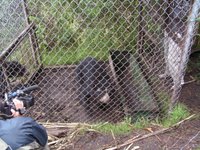

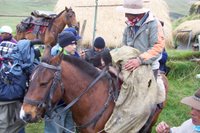
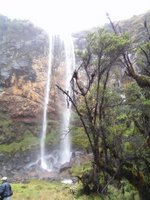

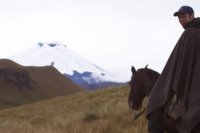





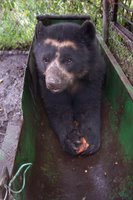

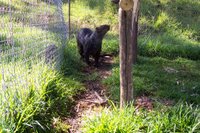
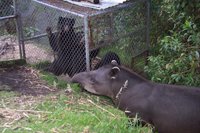












2 Comments:
Comment by luxury apartments buenos aires, at 11:29 AM
luxury apartments buenos aires, at 11:29 AM
What an incredible story! The treatment of the bear cub is heartbreaking.
Comment by Max Dsouza, at 8:21 AM
Max Dsouza, at 8:21 AM
It's a great grand blog post. I loved reading it as it is quite interesting stuff as similar as Blue waffles